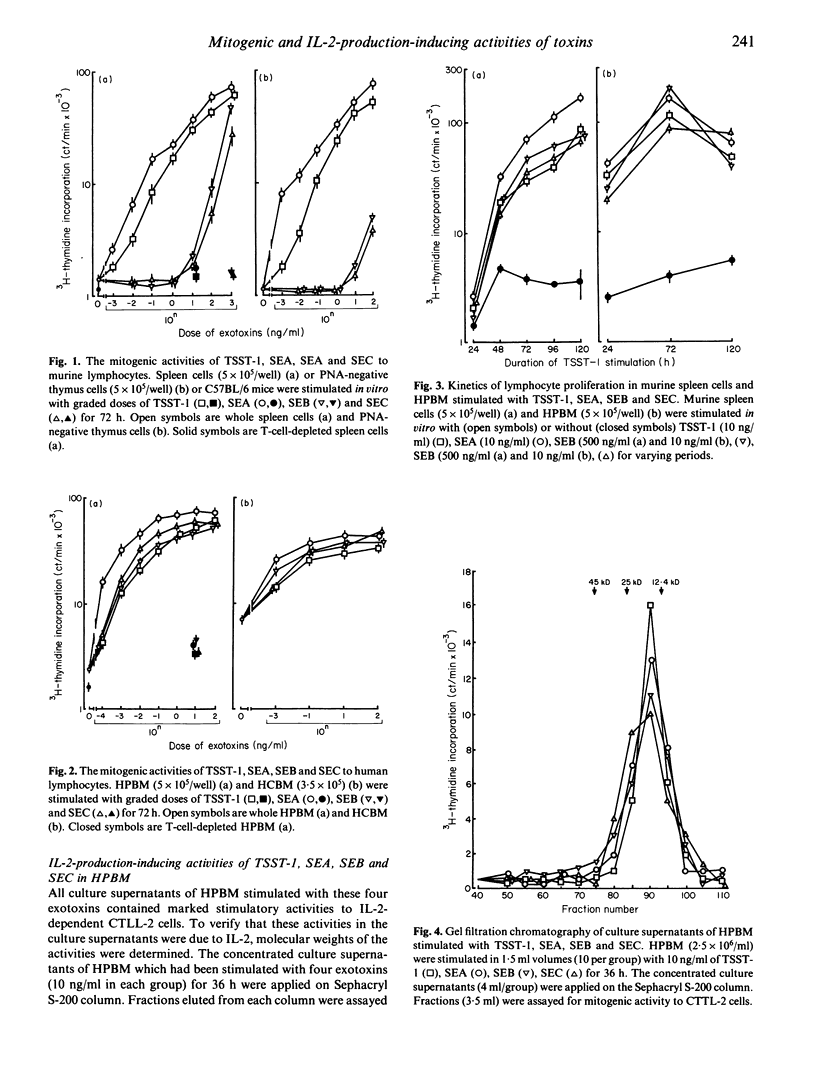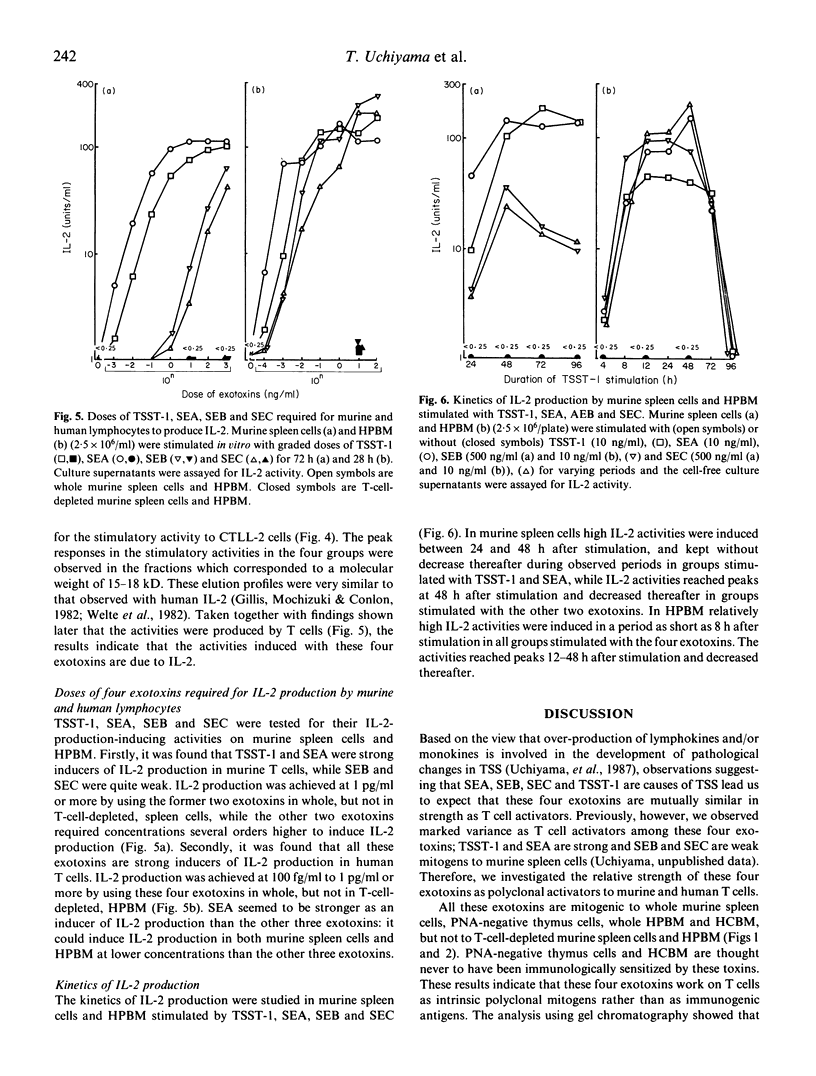Abstract
Several observations suggest that staphylococcal enterotoxins A, B and C (SEA, SEB and SEC, respectively), in addition to toxic shock syndrome toxin-1 (TSST-1), are causative exotoxins of toxic shock syndrome (TSS). Based on the view that polyclonal T cell activation with the causative exotoxins, resulting in over-production of lymphokines, is involved in the development of the pathological changes observed in TSS, we investigated the activities of these four exotoxins to induce proliferation and interleukin 2 production in murine and human lymphocytes by using in vitro culture systems. The results showed that all these exotoxins are strong polyclonal inducers of proliferation and interleukin 2 production in human T cells, whereas TSST-1 and SEA are strong and SEB and SEC are weak polyclonal inducers in murine T cells. These results suggest that SEA, SEB and SEC, in addition to TSST-1, are possibly involved as causative exotoxins in the development of the pathological changes observed in TSS.
Full text
PDF





Selected References
These references are in PubMed. This may not be the complete list of references from this article.
- Amento E. P., Kurnick J. T., Krane S. M. Interleukin 1 production by the human monocyte cell line U937 requires a lymphokine induction signal distinct from interleukin 2 or interferons. J Immunol. 1985 Jan;134(1):350–357. [PubMed] [Google Scholar]
- Beezhold D. H., Best G. K., Bonventre P. F., Thompson M. Synergistic induction of interleukin-1 by endotoxin and toxic shock syndrome toxin-1 using rat macrophages. Infect Immun. 1987 Dec;55(12):2865–2869. doi: 10.1128/iai.55.12.2865-2869.1987. [DOI] [PMC free article] [PubMed] [Google Scholar]
- Calvano S. E., Quimby F. W., Antonacci A. C., Reiser R. F., Bergdoll M. S., Dineen P. Analysis of the mitogenic effects of toxic shock toxin on human peripheral blood mononuclear cells in vitro. Clin Immunol Immunopathol. 1984 Oct;33(1):99–110. doi: 10.1016/0090-1229(84)90296-4. [DOI] [PubMed] [Google Scholar]
- Carlsson R., Fischer H., Sjögren H. O. Binding of staphylococcal enterotoxin A to accessory cells is a requirement for its ability to activate human T cells. J Immunol. 1988 Apr 15;140(8):2484–2488. [PubMed] [Google Scholar]
- Carlsson R., Sjögren H. O. Kinetics of IL-2 and interferon-gamma production, expression of IL-2 receptors, and cell proliferation in human mononuclear cells exposed to staphylococcal enterotoxin A. Cell Immunol. 1985 Nov;96(1):175–183. doi: 10.1016/0008-8749(85)90349-1. [DOI] [PubMed] [Google Scholar]
- Garbe P. L., Arko R. J., Reingold A. L., Graves L. M., Hayes P. S., Hightower A. W., Chandler F. W., Broome C. V. Staphylococcus aureus isolates from patients with nonmenstrual toxic shock syndrome. Evidence for additional toxins. JAMA. 1985 May 3;253(17):2538–2542. [PubMed] [Google Scholar]
- Gillis S., Ferm M. M., Ou W., Smith K. A. T cell growth factor: parameters of production and a quantitative microassay for activity. J Immunol. 1978 Jun;120(6):2027–2032. [PubMed] [Google Scholar]
- Gillis S., Mochizuki D. Y., Conlon P. J., Hefeneider S. H., Ramthun C. A., Gillis A. E., Frank M. B., Henney C. S., Watson J. D. Molecular characterization of interleukin 2. Immunol Rev. 1982;63:167–209. doi: 10.1111/j.1600-065x.1982.tb00415.x. [DOI] [PubMed] [Google Scholar]
- Gutterman J. U., Blumenschein G. R., Alexanian R., Yap H. Y., Buzdar A. U., Cabanillas F., Hortobagyi G. N., Hersh E. M., Rasmussen S. L., Harmon M. Leukocyte interferon-induced tumor regression in human metastatic breast cancer, multiple myeloma, and malignant lymphoma. Ann Intern Med. 1980 Sep;93(3):399–406. doi: 10.7326/0003-4819-93-3-399. [DOI] [PubMed] [Google Scholar]
- Igarashi H., Fujikawa H., Usami H., Kawabata S., Morita T. Purification and characterization of Staphylococcus aureus FRI 1169 and 587 toxic shock syndrome exotoxins. Infect Immun. 1984 Apr;44(1):175–181. doi: 10.1128/iai.44.1.175-181.1984. [DOI] [PMC free article] [PubMed] [Google Scholar]
- Ikejima T., Dinarello C. A., Gill D. M., Wolff S. M. Induction of human interleukin-1 by a product of Staphylococcus aureus associated with toxic shock syndrome. J Clin Invest. 1984 May;73(5):1312–1320. doi: 10.1172/JCI111334. [DOI] [PMC free article] [PubMed] [Google Scholar]
- Jupin C., Anderson S., Damais C., Alouf J. E., Parant M. Toxic shock syndrome toxin 1 as an inducer of human tumor necrosis factors and gamma interferon. J Exp Med. 1988 Mar 1;167(3):752–761. doi: 10.1084/jem.167.3.752. [DOI] [PMC free article] [PubMed] [Google Scholar]
- Kamagata Y., Oka M., Uchiyama T., Yoshioka M., Fujikawa H., Igarashi H. [Macrophage activating factor production by mice spleen cells with toxic-shock-syndrome toxin-1]. Kansenshogaku Zasshi. 1987 Aug;61(8):907–913. doi: 10.11150/kansenshogakuzasshi1970.61.907. [DOI] [PubMed] [Google Scholar]
- Lotze M. T., Matory Y. L., Ettinghausen S. E., Rayner A. A., Sharrow S. O., Seipp C. A., Custer M. C., Rosenberg S. A. In vivo administration of purified human interleukin 2. II. Half life, immunologic effects, and expansion of peripheral lymphoid cells in vivo with recombinant IL 2. J Immunol. 1985 Oct;135(4):2865–2875. [PubMed] [Google Scholar]
- Micusan V. V., Mercier G., Bhatti A. R., Reiser R. F., Bergdoll M. S., Oth D. Production of human and murine interleukin-2 by toxic shock syndrome toxin-1. Immunology. 1986 Jun;58(2):203–208. [PMC free article] [PubMed] [Google Scholar]
- Oda T. [Application of SP-sephadex chromatography to the purification of staphylococcal enterotoxins A, B and C2 (author's transl)]. Nihon Saikingaku Zasshi. 1978;33(6):743–752. [PubMed] [Google Scholar]
- Parsonnet J., Gillis Z. A., Richter A. G., Pier G. B. A rabbit model of toxic shock syndrome that uses a constant, subcutaneous infusion of toxic shock syndrome toxin 1. Infect Immun. 1987 May;55(5):1070–1076. doi: 10.1128/iai.55.5.1070-1076.1987. [DOI] [PMC free article] [PubMed] [Google Scholar]
- Poindexter N. J., Schlievert P. M. Toxic-shock-syndrome toxin 1-induced proliferation of lymphocytes: comparison of the mitogenic response of human, murine, and rabbit lymphocytes. J Infect Dis. 1985 Jan;151(1):65–72. doi: 10.1093/infdis/151.1.65. [DOI] [PubMed] [Google Scholar]
- Rasheed J. K., Arko R. J., Feeley J. C., Chandler F. W., Thornsberry C., Gibson R. J., Cohen M. L., Jeffries C. D., Broome C. V. Acquired ability of Staphylococcus aureus to produce toxic shock-associated protein and resulting illness in a rabbit model. Infect Immun. 1985 Mar;47(3):598–604. doi: 10.1128/iai.47.3.598-604.1985. [DOI] [PMC free article] [PubMed] [Google Scholar]
- Reisner Y., Linker-Israeli M., Sharon N. Separation of mouse thymocytes into two subpopulations by the use of peanut agglutinin. Cell Immunol. 1976 Jul;25(1):129–134. doi: 10.1016/0008-8749(76)90103-9. [DOI] [PubMed] [Google Scholar]
- Uchiyama T., Kamagata Y., Wakai M., Yoshioka M., Fujikawa H., Igarashi H. Study of the biological activities of toxic shock syndrome toxin-1. I. Proliferative response and interleukin 2 production by T cells stimulated with the toxin. Microbiol Immunol. 1986;30(5):469–483. doi: 10.1111/j.1348-0421.1986.tb02973.x. [DOI] [PubMed] [Google Scholar]
- Uchiyama T., Kamagata Y., Yan X. J., Kohno M., Yoshioka M., Fujikawa H., Igarashi H., Okubo M., Awano F., Saito-Taki T. Study of the biological activities of toxic shock syndrome toxin-1: II. Induction of the proliferative response and the interleukin 2 production by T cells from human peripheral blood mononuclear cells stimulated with the toxin. Clin Exp Immunol. 1987 Jun;68(3):638–647. [PMC free article] [PubMed] [Google Scholar]
- Uchiyama T., Kamagata Y., Yoshioka M. Mechanism of lipopolysaccharide-induced immunosuppression: immunological activity of B cell subsets responding to T-dependent or T-independent antigens in lipopolysaccharide-preinjected mice. Infect Immun. 1984 Aug;45(2):367–371. doi: 10.1128/iai.45.2.367-371.1984. [DOI] [PMC free article] [PubMed] [Google Scholar]
- Welte K., Wang C. Y., Mertelsmann R., Venuta S., Feldman S. P., Moore M. A. Purification of human interleukin 2 to apparent homogeneity and its molecular heterogeneity. J Exp Med. 1982 Aug 1;156(2):454–464. doi: 10.1084/jem.156.2.454. [DOI] [PMC free article] [PubMed] [Google Scholar]


